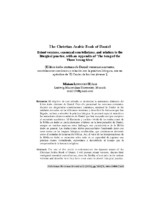Mostrar el registro sencillo del ítem
The Christian Arabic Book of Daniel. Extant versions, canonical constellations, and relation to the liturgical practice, with an Appendix of ‘The Song of the Three Young Men’
| dc.contributor.author | Lindgren Hjäjm, Miriam | es_Es |
| dc.date.accessioned | 2016-07-07T11:16:54Z | |
| dc.date.available | 2016-07-07T11:16:54Z | |
| dc.date.issued | 2015 | |
| dc.identifier.issn | 1697-2104 | |
| dc.identifier.uri | http://hdl.handle.net/10396/13775 | |
| dc.description.abstract | El objetivo de este artículo es demostrar la naturaleza dinámica del Libro árabe cristiano de Daniel. Para ello presentaré las versiones existentes, discutir sus abigarradas constelaciones canónicas, mostraré la fluidez de las unidades textuales en las diferentes versiones y describiré la forma en que han llegado, incluso, a absorber la práctica litúrgica. Se prestará especial atención a las narraciones deuterocanónicas de Daniel que han escapado casi por completo al escrutinio académico. El fluctuante y carácter vívido de las traducciones de la Biblia en árabe es particularmente evidente en la interpretación de Daniel, aunque en muchos aspectos estos hallazgos son característicos de la Biblia árabe en general. Las traducciones árabes parecen haber funcionado junto con otros textos en las lenguas litúrgicas establecidas, que continuaron sirviendo como el estándar de la narración bíblica. Así, el valor de las interpretaciones de la Biblia en árabe se encuentra sobre todo en su capacidad de capturar una práctica menos formalizada, espontánea y desinhibida al tiempo que la comprensión de la herencia religiosa. | es_ES |
| dc.description.abstract | The aim of this article is to demonstrate the dynamic nature of the Christian Arabic Book of Daniel. I will present extant versions, discuss their variegated canonical constellations, show the fluidity of text units in the various versions and describe how they have even come to absorb liturgical practice. Special attention will be paid to the deuterocanonical narratives related to the Book of Daniel that have almost completely escaped scholarly scrutiny. The fluctuating and vivid character of Arabic Bible translations is particularly evident in the rendition of Daniel, yet in many aspects these findings are characteristic of the Arabic Bible enterprise at large. Arabic translations appear to have functioned alongside texts in the established liturgical languages which continued to serve as the measuring standard of the biblical narrative. Thus, the value of the Arabic Bible renditions lies foremost in their ability to capture a less formalized, spontaneous, and uninhibited practice and understanding of the religious heritage. | es_ES |
| dc.format.mimetype | application/pdf | es_ES |
| dc.language.iso | eng | es_ES |
| dc.publisher | Universidad de Córdoba, UCOPress | es_ES |
| dc.rights | https://creativecommons.org/licenses/by/3.0/ | es_ES |
| dc.source | Collectanea Christiana Orientalia 12, 115-178 (2015) | es_ES |
| dc.subject | Árabe cristiano | es_ES |
| dc.subject | Biblia | es_ES |
| dc.subject | Daniel | es_ES |
| dc.subject | Textos deuterocanónicos | es_ES |
| dc.subject | Christian Arabic | es_ES |
| dc.subject | Bible | es_ES |
| dc.subject | Deuterocanonical texts | es_ES |
| dc.title | The Christian Arabic Book of Daniel. Extant versions, canonical constellations, and relation to the liturgical practice, with an Appendix of ‘The Song of the Three Young Men’ | es_ES |
| dc.title.alternative | El libro árabe cristiano de Daniel: versiones existentes, constelaciones canónicas y relación con la práctica litúrgica, con un apéndice de ‘El Cantar de los tres jóvenes’ | es_ES |
| dc.type | info:eu-repo/semantics/article | es_ES |
| dc.relation.publisherversion | http://www.uco.es/servicios/publicaciones/revistas/index.php/cco/index | es_ES |
| dc.rights.accessRights | info:eu-repo/semantics/openAccess | es_ES |

